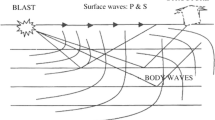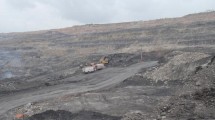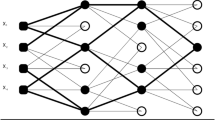Abstract
Blasting has been widely used as an accepted mechanism in mining, construction, and rock engineering projects. However, inappropriate control of the blasting-induced ground vibration as an inevitable side effect can cause severe problem for the nearby areas. Therefore, developing the predictive models to estimate the blasting-induced ground vibrations can be considered as an attractive practical issue in engineering projects both in designing and operational stages. In the present paper, blasting-induced ground vibration at Masjed Soleyman earth dam in southwest of Iran in terms of peak particle velocity (PPV) using two different artificial neural network (ANN)-based models has been assessed and predicted. The multilayer perceptron (MLP) and generalized feed forward neural network (GFNN) were developed and optimized using monitored blast records. The total charge, charge per delay, and distance from blasting point were the input parameters. The quality and performance of introduced ANN topologies were compared to known conventional empirical predictors and then examined by different statistical indices and sensitivity analyses criteria. Although both GFNN and MLP indicated higher degree of safety and reliability in prediction of PPV, but the validation process using the unseen randomized data highlighted better performance and more accuracy in GFNN model with respect to MLP and common empirical predictors. Therefore, the GFNN with 3-4-3-1 structure and R2 = 0.954 between the measured and predicted PPV values was recognized as the optimized developed structure for the studied area.









Similar content being viewed by others
References
Cheng G, Huang SL (2000) Analysis of ground vibration caused by open pit production blast. In: Holmberg (Ed.), Explosive and blasting technique, CRC Press, Balkema, pp 63–70
Hagan TN (1973) Rock breakage by explosives. In Proceedings of the national symposium on rock fragmentation, Adelaide, pp 1–17
Hakan AK, Konuk A (2008) The effect of discontinuity frequency on ground vibrations produced from bench blasting: a case study. Soil Dyn Earthq Eng 28:686–694
Khandelwal M, Singh TN (2009) Prediction of blast-induced ground vibration using artificial neural network. Int J Rock Mech Min Sci 46:1214–1222
Monjezi M, Ghafurikalajahi M, Bahrami A (2011) Prediction of blast-induced ground vibration using artificial neural networks. Tunn Undergr Space Technol 26:46–50
Li P, Lu WB, Wu XX, Chen M, Yan P, Hu YG (2017) Spectral prediction and control of blast vibrations during the excavation of high dam abutment slopes with millisecond-delay blasting. Soil Dyn Earthq Eng 94:116–124
Monjezi M, Hasanipanah M, Khandelwal M (2013) Evaluation and prediction of blast-induced ground vibration at Shur River Dam, Iran, by artificial neural network. Neural Comput Appl 22:1637–1643
Parida A, Mishra MK (2015) Blast vibration analysis by different predictor approaches-A comparison. Procedia Earth Planet Sci 11:337–345
Saadat M, Khandelwal M, Monjezi M (2014) An ANN-based approach to predict blast-induced ground vibration of Gol-E-Gohar iron ore mine, Iran. J Rock Mech Geotech Eng 6:67–76
Ambraseys NR, Hendron AJ (1968) Dynamic behavior of rock masses, rock mechanics in engineering practices. Wiley, London
Duvall WI, Johnson CF, Meyer AVC (1963) Vibrations from instantaneous and millisecond delay quarry blasts. RI. 6151. US, Bureau of Mines, United States Department of Interior, Washington
Duvall WI, Fogelson DE (1962) Review of criteria for estimating damages to residences from blasting vibrations. R. I. 5968, US, Bureau of Mines
Langefors U, Kihlström B (1978) The modern technique of rock blasting, 3rd edn. Wiley, New York
Nicholls HR, Johnson CF, Duvall WI (1971) Blasting vibrations and their effects on structures. United States Department of Interior, USBM, Bulletin, p 656
Birch WJ, Chaffer R (1983) Prediction of ground vibration from blasting on open cast sites. Trans Inst Min Metall Sec A 92:A102–A107
Ghosh A, Daemen JK (1983) A simple new blast vibration predictor, In: Proceedings of the 24th US symposium on rock mechanics, College Station, Texas, pp 151–61
Gupta RN, Roy PP, Bagachi A, Singh B (1987) Dynamics effects in various rock mass and their predictions. J Mines Met Fuels 35:455–462
Pal Roy P (1993) Putting ground vibration predictors into practice. Colliery Guard 241:63–67
ISRM (1992) Suggested method for blast vibration monitoring. Int J Rock Mech Min Sci Geomech Abst 29:145–146
Majdi A, Rezaei M (2013) Prediction of unconfined compressive strength of rock surrounding a roadway using artificial neural network. Neural Comput Appl 23:381–389
Yurdakul M, Akdas H (2013) Modeling uniaxial compressive strength of building stones using non-destructive test results as neural networks input parameters. Constr Build Mater 47:1010–1019
Dowding CH (1985) Blast vibration monitoring and control. Prentice-Hall Inc, Englewood’s Cliffs, pp 288–290
Khandelwal M, Singh TN (2007) Evaluation of blast induced ground vibration predictors. Soil Dyn Earthq Eng 27:116–125
Abbaszadeh Shahri A (2016) An optimized artificial neural network structure to predict clay sensitivity in a high landslide prone area using piezocone penetration test (CPTu) data: a case study in southwest of Sweden. Geotech Geol Eng 34(2):745–758
Abbaszadeh Shahri A, Larsson S, Johansson F (2015) CPT-SPT correlations using artificial neural network approach- A case study in Sweden. Electron J Geotech Eng (EJGE) 20 (Bund. 28):13439–13460
Abbaszadeh Shahri A (2016) Assessment and prediction of liquefaction potential using different artificial neural network models—a case study. Geotech Geol Eng 34(3):807–815
Fausett L (1994) Fundamentals of neural networks: architectures, and applications. Prentice-Hall, Englewood Cliffs, NJ
Rezaei M, Monjezi M, Ghorbani Moghaddam S, Farzaneh F (2011) Burden prediction in blasting operation using rock geomechanical properties. Arab J Geosci. https://doi.org/10.1007/s12517-010-0269-0
Davies B, Farmer IW, Attewell PB (1964) Ground vibration from shallow sub-surface blasts. The Engineer 217:553–559
Oakley J, O’Hagan A (2004) Probabilistic sensitivity analysis of complex models: a Bayesian approach. J R Stat Soc B 66:751–769
Sobol I (1993) Sensitivity analysis for non-linear mathematical models. Math Modeling Comput Exp (Engl. Transl.) 1:407–414
Storlie CB, Swiler LP, Helton JC, Sallaberry CJ (2009) Implementation and evaluation of nonparametric regression procedures for sensitivity analysis of computationally demanding models. Reliab Eng Syst Saf 94(11):1735–1763
Jong YH, Lee CI (2004) Influence of geological conditions on the powder factor for tunnel blasting. Int J Rock Mech Min Sci 41(Supplement 1):533–538
Gevrey M, Dimopoulos I, Lek S (2003) Review and comparison of methods to study the contribution of variables in artificial neural network models. Ecol Model 160(3):249–264
Tchaban T, Taylor MJ, Griffn JP (1998) Establishing impacts of the inputs in a feed forward neural network. Neural Comput Appl 7(4):309–317
Mostafa TM (2009) Artificial neural network for prediction and control of blasting vibrations in Assiut (Egypt) limestone quarry. Int J Rock Mech Min Sci 46(2):426–431
Wiss JF, Linehan PW (1987) Control of vibration and air noise from surface coal mines—III. US Bureau of Mines Report OFR, 103(3)–79, p. 623
Esmaeilabadi R, Abbaszadeh Shahri A (2016) Prediction of site response spectrum under earthquake vibration using an optimized developed artificial neural network model. Adv Sci Technol Res J 10(30):76–83
Roy PP (1991) Vibration control in an opencast mine based on improved blast vibration predictors. Min Sci Technol 12:157–165
Bureau of Indian Standard (1973) Criteria for safety and design of structures subjected to underground blast. ISI Bull IS-6922
Author information
Authors and Affiliations
Corresponding author
Rights and permissions
About this article
Cite this article
Abbaszadeh Shahri, A., Asheghi, R. Optimized developed artificial neural network-based models to predict the blast-induced ground vibration. Innov. Infrastruct. Solut. 3, 34 (2018). https://doi.org/10.1007/s41062-018-0137-4
Received:
Accepted:
Published:
DOI: https://doi.org/10.1007/s41062-018-0137-4




